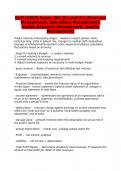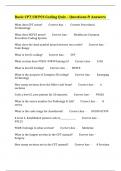DLM (ASCP) Exam- 261 Q’s and A’s (Financial
Management, Operations Management,
Human Resource Management, Quality
Management)
Project Volumes (forecasting stage) - -based on expert opinion, stats,
historical data, shifts in patient mix, changes in medical staff composition,
changes in inflation/reimbursement ratws, expansion/cutbacks, population
fluctuations based on economy
-Steps to creating a budget - -1. project volumes
2. convert volumes to revenue
3. convert volumes into expense requirements
4. Adjust revenue/ expenses as necessary to meet budget margin
-gross revenue - -Rates x Production Unit (Billable test volume)
-Expenses - -salaries/wages, reference service, instrument lease,
maintenance contracts, education/travel
-Financial Statements - -convey the financial status of an organization
4 main types - income statement, balance sheet statement of changes in
equity and statement of cash flows.
-income statement - -summarizes the operations of an organization with a
focus on its revenues, expenses, and profitability. contains operational
results over a period of time.
-depreciation - -noncash charge against earnings on income statement that
reflect the "wear and tear" on a business' fixed assets (property and
equipment). loss of value
-salvage value - -amount received when final disposition occurs at end of
the asset's useful life.
-annual depreciation - -(initial cost - salvage value)/ useful life
-Profit - -net income -expense
-cashflow - -net income + depreciation
-Total Profit Margin - -Net income divided by total revenues. It measures the
amount of total profit per dollar of total revenues.
, -fixed costs - -cost not related to the volume of services delivered (ex.
facilities cost, lab admin, instrument leases, maintenance contracts)
-variable cost - -directly related to the volume of services delivered (ex.
supplies, labor costs)
-Profit Analysis - -technique use to analyze the effects of volume changes
on profit. can also be used to analyze effects of volume changes on costs.
-Total Costs - -fixed costs + variable costs
Variable costs = variable cost rate x volume
-contribution margin - -difference between per unit revenue and per unit
variable cost. gives the amount left to cover the fixed costs. after fixed costs
are covered what's left contributes to the profit.
-accounting breakeven - -Volume needed to produce zero profit. Revenues
cover all accounting costs.
Total Revenue (cost x volume) - Total Variable (variable cost rate x volume) -
fixed costs = $0
-economic breakeven - -occurs when all accounting costs plus a profit
target are covered
total revenue - total variable cost- fixed cost = profit
-Surcharge/Cost Plus - -used for reference/send out testing. Determine cost
of doing a procedure then add markup factor to get appropriate price.
-weight value basis - -each test performed is assigned a weight based on
cost of performing the test in relation to the procedure.
-patient day factor - -the number of patients in a hospital on a given day.
(average patient day/ daily census for the year) x 365
-tests per patient days - -test volume/ patient days
-revenue per test - -gross revenue/test volume
-direct costs - -test-specific costs (Variable)
examples - supplies, instrumentation, reagents, tech time
-indirect cost - -remain constant
examples - lab admin, medical records, house keeping, utilities, etc.
(fixed/semi-variable)
-unit costs - -total direct + indirect expenses
, -Employment cycle - -covers all stages in the process of employing staff:
1. recruitment and acquisition costs (pre-employment screen)
2. training/developmental costs (ongoing)
3. productive/operational periods
4. termination/separation of employee from institution costs
-analyze labor costs - -institutional labor cost evaluation (employment
cycle)
technical evaluation of labor cost - assign labor costs to production activities
that generate expenses. helps manager identify where efforts are being
expended and productivity
accounting and budgeting labor analysis - helps monitor staffing levels,
productivity and management performance against budget objectives
-preanalytical time - -specimen collection, prep, instrument
-analytical time - -performing/resulting tests
-post analytical time - -reporting and routine maintenance
-total hours - -productive hours + nonproductive hours
-productive hours - -actual worked hours includes overtime and training
-nonproductive hours - -compensated but not worked. sick leave, vacation,
bereavement, etc.
-Full-time equivalent (FTE) - -An employee who works full-time, 40 hours per
week, 2080 hours per year (total number of hours paid/ 2080)
171 or 177 hours - per month
-Productivity Measurement - -workload unit (WLU)/ labor units
-time studies - -time required for handling, testing, recording and reporting,
daily and periodic activities, maintenance and repair, and direct technical
supervision.
-paid productivity - -tests/ number paid hours
number of tests performed per paid hour.
-worked productivity - -tests/ number worked hours
number of tests performed per worked hour
-projected salary - -total paid hours x average hourly rate





